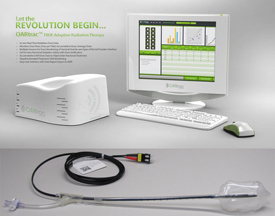BERKELEY, CA (UroToday.com) - This work evaluated the dosimetric accuracy of a new commercial in vivo dosimetry system, the OARtrac produced by Radiadyne LLC. This device is based on a research system built in Dr. Sam Beddar’s lab[1] at The University of Texas, MD Anderson Cancer Center, and is designed to measure the dose delivered to patients undergoing radiation therapy treatments. The system is also designed to detect and prevent potential treatment delivery errors by monitoring the dose being received by the patient in real-time. The motivation for this device is past high-profile misadministrations with severe and occasionally even fatal outcomes for patients.[2, 3, 4, 5, 6] The OARtrac system addresses this problem by allowing measurement of dose delivered inside of the patient while the treatment is being delivered. Therefore, this system has the ability to detect potentially large errors within a fraction of the treatment before the delivery of the entire daily radiation dose.
 The OARtrac system consists of disposable endorectal balloons with plastic scintillation detectors embedded in the balloon lumen. The detectors can be optically connected to a charge-coupled device (CCD) camera that is then read out by a dedicated OARtrac computer to quantify the delivered dose. The detectors come calibrated, and a barcode reader supplied with the system is used to scan a barcode on each balloon supplying the appropriain vivote calibration factors to the computer. Relevant patient-specific information is supplied by the user to produce documentation of the dose delivered that day, providing the additional benefit of independent documentation of treatment delivery.
The OARtrac system consists of disposable endorectal balloons with plastic scintillation detectors embedded in the balloon lumen. The detectors can be optically connected to a charge-coupled device (CCD) camera that is then read out by a dedicated OARtrac computer to quantify the delivered dose. The detectors come calibrated, and a barcode reader supplied with the system is used to scan a barcode on each balloon supplying the appropriain vivote calibration factors to the computer. Relevant patient-specific information is supplied by the user to produce documentation of the dose delivered that day, providing the additional benefit of independent documentation of treatment delivery.
Dr. Geoffrey Ibbott, Director of the M. D. Anderson Dosimetry Laboratory (MDADL) and Chair of the Radiation Physics department at MD Anderson Cancer Center, is one of the collaborators on this project. His calibration laboratory is instrumental to the OARtrac system, as the MDADL is responsible for individually calibrating the detectors that are embedded in the endorectal balloons as well as calibrating the CCD monitoring systems. Cobalt calibration is used for high accuracy and reproducibility. The MDADL was also instrumental in designing a user-friendly quality assurance test procedure to ensure accurate system performance.
The dosimetric evaluation measurements were performed by Dr. Slade Klawikowski and Dr. Clint Zeringue in a phantom to control the in vivo uncertainties such as anatomical movement and localization, in preparation for future patient in vivo measurements. In total, 94 detectors were tested; each detector was placed in a Solid Water® Phantom and irradiated with 6 MV beams in a four field box pattern to a cumulative dose of 200 cGy. As reported in our paper, the detectors performed well: the mean deviation from 200 cGy was only 0.01%, indicating excellent accuracy, and the 2 sigma spread (expected to encompass 95% of measurements performed with the detector) was 5.4%, indicating good precision as well.
Reference:
- L.S. Wootton, R.J. Kudchadker, A.K. Lee, S. Beddar, “Real-time in vivo rectal wall dosimetry using plastic scintillation detectors for patients with prostate cancer,” Phys. Med. Biol. 59, 647-660 (2014)
- S. Derreumaux, C. Etard, C. Huet, F. Trompier, I. Clairand, J.-F. Bottolier-Depois, B. Aubert, and P. Gourmelon, “Lessons from recent accidents in radiation therapy in France,” Radiat. Prot. Dosim. 131, 130-135 (2008).
- International Commission on Radiological Protection, “ICRP Publication 112: Preventing accidental exposure from new external beam radiation therapy technologies,” Ann. ICRP 39(4), 1-86 (2009).
- W. Bogdanich, “Radiation offers new cures, and ways to do harm,” New York Times, January 23 2010.
- W. Bogdanich, “A pinpoint beam strays invisibly, harming instead of healing,” New York Times, December 29, 2010.
- W. Bogdanich, “As technology surges, radiation safeguards lag,”sNew York Times, January 26, 2010.
Written by:
Sam Beddar as part of Beyond the Abstract on UroToday.com. This initiative offers a method of publishing for the professional urology community. Authors are given an opportunity to expand on the circumstances, limitations etc... of their research by referencing the published abstract.
Department of Radiation Physics, The University of Texas MD Anderson Cancer Center, Houston, TX USA
The University of Texas Graduate School of Biomedical Sciences at Houston, Houston, TX USA

More Information about Beyond the Abstract


